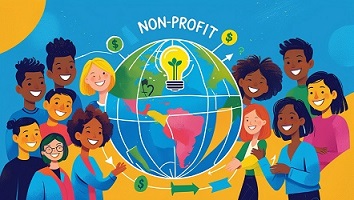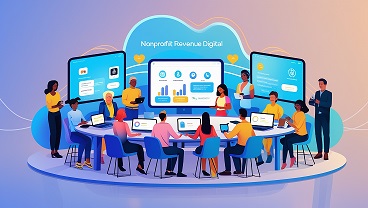Ever stared at your non-profit’s bank account and wondered if you’re supposed to feel guilty about wanting more zeros? You’re not alone. 78% of non-profit leaders secretly stress about money while publicly maintaining their “mission over money” smile.
Let’s cut through the idealistic nonsense. Non-profits absolutely can (and should) make money while staying true to their mission. The trick isn’t choosing between impact and income—it’s strategically aligning them.
In this guide, I’ll show you how successful non-profit organizations make money without compromising their values. No theoretical fluff, just practical strategies that work in 2025’s challenging funding landscape.
But before I reveal the five revenue models that are transforming the sector, there’s a critical mindset shift you need to make—one that separates thriving non-profits from those constantly scrambling for their next grant.
Understanding Revenue Streams Compatible with Nonprofit Values

Identifying sustainable funding options aligned with your mission
Nonprofit fundraising doesn’t mean compromising your values. In fact, the most successful nonprofits generate revenue through activities that reinforce their mission, not distract from it.
Start by mapping your core competencies against market opportunities. What skills, expertise, or assets does your organization already have that others might value? A youth education nonprofit might create paid training programs for teachers. An environmental group could sell sustainable products that demonstrate their principles in action.
The sweet spot? Revenue streams that actually advance your mission while they generate income. Think about it – when the ASPCA sells pet insurance, they’re both earning money AND ensuring more animals get medical care. That’s alignment at its best.
Here are five mission-aligned funding options worth exploring:
- Program service fees (sliding scale to maintain accessibility)
- Social enterprise initiatives (selling products/services related to your cause)
- Consulting/training in your area of expertise
- Licensing your intellectual property
- Impact investments (attracting capital that values both financial and social returns)
The difference between profit-making and profit distribution
Here’s a truth many nonprofit leaders miss: making money isn’t the problem. It’s what you do with it that matters.
Nonprofits absolutely can (and should) generate profits. The key difference is that while a business distributes profits to owners or shareholders, nonprofits must reinvest that money back into their mission. Every dollar of surplus goes toward expanding your impact, not enriching individuals.
This distinction is crucial because it liberates you to pursue robust revenue generation without feeling like you’re selling out. You’re not becoming “too commercial” by creating financial sustainability – you’re being responsible.
Think of it this way: Amazon generates profits to benefit shareholders. Goodwill generates profits to fund job training programs. Both make money, but with fundamentally different purposes.
Many of the world’s highest-impact nonprofits operate with healthy margins. They’re just strategic about how they deploy those resources to advance their cause.
Legal considerations for nonprofit revenue generation
Navigating the legal landscape of nonprofit income can feel like walking through a minefield, but it doesn’t have to be so scary.
The big concern is Unrelated Business Income Tax (UBIT). When your revenue-generating activities don’t substantially relate to your exempt purpose, that income becomes taxable. But don’t let this scare you away from diversifying your funding.
A few practical guidelines to stay on the right side of regulations:
- Document how each revenue stream connects to your mission
- Keep detailed financial records separating exempt and non-exempt activities
- Consider creating a separate for-profit subsidiary for unrelated business activities
- Stay below the threshold where unrelated income could jeopardize your tax status
Different states have varying requirements too. In California, for example, commercial activities face stricter scrutiny than in Wyoming or Delaware.
The IRS gives you more leeway than you might think. A museum gift shop selling educational items? Typically exempt. The same museum running a catering business? That’s likely subject to UBIT.
Balancing financial sustainability with social impact
The nonprofit paradox: pursuing financial health while maximizing mission impact. These goals can feel at odds, but they’re actually two sides of the same coin.
Financial sustainability isn’t just about keeping the lights on. It’s about independence, resilience, and the freedom to say “no” to funding that comes with strings attached. When you’re not constantly scrambling for your next grant, you can make decisions based on impact, not survival.
Some practical approaches:
Build a portfolio of funding sources with different risk profiles. Maybe 60% from reliable, proven revenue streams and 40% from newer, experimental approaches.
Measure both financial and social returns on each initiative. A program with high mission impact but negative financial returns might be balanced by another with moderate impact but strong financial performance.
Create feedback loops between your impact measurement and financial planning. When you understand which activities drive the most change per dollar invested, you can allocate resources more effectively.
The most successful nonprofits reject the false choice between money and mission. They recognize that without financial strength, even the most inspiring mission eventually falters. And without authentic impact, even the most profitable nonprofit loses its reason for existence.
Read more: Largest non governmental organization all over world
Earned Income Strategies for Mission-Aligned Revenue

A. Developing Products or Services Related to Your Cause
Money doesn’t have to be a dirty word for non-profits. In fact, the smartest organizations are creating products and services that generate revenue while reinforcing their mission.
Take the World Wildlife Fund’s gift shop. Those adorable plush pandas aren’t just cute – they’re cash flow. Every purchase supports conservation efforts. Or consider Goodwill, which turned donated goods into a retail empire that funds job training programs.
The key is authenticity. Your products should directly connect to what you stand for.
A food bank might create a cookbook featuring budget-friendly recipes using pantry staples. An environmental group could sell reusable products that reduce waste. A literacy nonprofit might publish children’s books.
Want to get started? Try this:
- Identify your unique assets and expertise
- Look for gaps in the market related to your cause
- Start small with minimal investment
- Test with your existing supporters first
- Scale what works
Remember: your supporters aren’t just buying a product – they’re buying into your mission. Make sure every purchase tells that story.
B. Monetizing Expertise Through Consulting or Training
Your nonprofit has something incredibly valuable: specialized knowledge. People will pay for that expertise!
Think about it. An organization fighting homelessness understands housing policy better than most government officials. A disability rights group knows more about accessibility than most architects. That knowledge is worth money.
Here’s how smart nonprofits are cashing in:
- Workshops and seminars: Charge businesses to train their staff on issues related to your cause
- Consulting services: Offer paid guidance to companies wanting to improve their practices
- Speaking engagements: Your leadership can command fees for sharing insights at conferences
- Technical assistance: Help other organizations implement programs similar to yours
The American Heart Association doesn’t just advocate for heart health – they certify CPR trainers and charge for those certifications. The revenue supports their broader mission while spreading life-saving skills.
What expertise could you package and sell? Maybe you’re amazing at volunteer management, fundraising, or program evaluation. Other organizations would gladly pay to learn from your success.
C. Creating Subscription Models for Sustained Income
Subscription models aren’t just for Netflix and meal kits. They’re a game-changer for nonprofits looking for reliable, recurring revenue.
The beauty of subscriptions? Predictable cash flow. When you know what’s coming in each month, you can plan better and stress less.
Smart nonprofits are creating membership programs that offer exclusive benefits while generating steady income. The Sierra Club’s membership provides special access to outings and publications. Museums offer member-only hours and discounts.
But you can get creative beyond traditional memberships:
- Content subscriptions: Monthly digital resources, research reports, or specialized newsletters
- Giving circles: Recurring donation groups with special access to impact reports
- Product subscriptions: Monthly boxes of mission-related items (think fair trade products or sustainable goods)
- Service subscriptions: Regular access to facilities, equipment, or expertise
The trick is offering genuine value that supporters can’t get elsewhere. Make them feel like insiders who are making a difference through their ongoing support.
What could you offer on a subscription basis that would excite your supporters while advancing your mission?
D. Licensing Intellectual Property or Methodologies
Your nonprofit has probably developed something unique – a curriculum, an assessment tool, a program model, or even a catchy slogan. That intellectual property could be your ticket to sustainable funding.
Many organizations are sitting on goldmines without realizing it. The Girl Scouts don’t just sell cookies – they license their name and logo to companies that want to associate with their respected brand.
Here’s what you might be able to license:
- Program models: Your proven approach to solving a problem
- Training materials: Curricula you’ve developed for specific audiences
- Assessment tools: Evaluation instruments or metrics you’ve created
- Technology: Apps or software developed for your work
- Brand assets: Your name, logo, or slogans
Licensing works because it leverages what you’ve already built. You do the work once, then earn income repeatedly as others use your IP.
The key is protecting what’s yours. Get proper legal advice about trademarks, copyrights, and licensing agreements before moving forward. Then find partners who will respect your mission while implementing your methods.
Read more: Group purchasing organizations list GPOs know which one is right
Earned Income Strategies for Mission-Driven Organizations

Developing Products or Services That Further Your Cause
Nonprofits often struggle with balancing financial sustainability and mission integrity. But here’s the thing – you don’t have to choose between making money and making a difference.
Creating products or services that directly advance your mission is a winning strategy. Think about what you’re already good at, then package it up in a way people will pay for.
Take the World Wildlife Fund, for instance. They didn’t just ask for donations – they created a whole merchandise line featuring endangered species. Every purchase both raises awareness and funds conservation efforts. That’s not just clever marketing; it’s mission amplification.
The key is authenticity. Your products should reflect what your organization stands for. If you’re a job training nonprofit, selling resume services to corporations makes sense. If you’re an environmental organization, launching a plastic water bottle wouldn’t exactly hit the mark, would it?
Ask yourself:
- What expertise do we already have in-house?
- What do our supporters consistently ask us for?
- What problems do we solve that others might pay to have solved?
Fee-for-Service Models That Support Core Programs
Want to know what separates thriving nonprofits from the ones barely hanging on? It’s simple – sustainable revenue through fee-for-service models.
Museums charge admission while still offering free days for accessibility. Mental health nonprofits use sliding scale therapy fees. Environmental organizations offer paid consultation to businesses wanting to reduce their carbon footprint.
The trick is setting the right price point. Too high, you lose accessibility. Too low, you’re back at square one financially.
YWCA nailed this balance by offering affordable childcare services that fund their programs for women’s empowerment. They serve families who can pay while using that revenue to support those who can’t.
Some practical approaches:
- Sliding scale pricing based on ability to pay
- Tiered service levels (basic free, premium paid)
- Corporate training packages that subsidize community services
Social Enterprise Ventures: Case Studies of Success
The most innovative nonprofits aren’t waiting for donations to drop from the sky. They’re building businesses that fund their missions.
Greyston Bakery’s slogan says it all: “We don’t hire people to bake brownies; we bake brownies to hire people.” This social enterprise supplies brownies to Ben & Jerry’s while employing people facing barriers to employment. The business funds their workforce development mission, creating a beautiful cycle of impact.
Or look at Goodwill. They turned donated items into a retail empire that funds job training programs. Their stores generated $5.9 billion in revenue in 2024, supporting employment services for over 1.5 million people.
The Grameen Bank revolutionized microfinance while creating a sustainable business model. They don’t just give handouts – they provide loans with reasonable interest rates that fund their operations.
What makes these ventures work? They:
- Directly connect to the mission
- Leverage existing strengths and resources
- Create multiple forms of value (social and financial)
- Scale what works, abandon what doesn’t
Your nonprofit already has assets, expertise, and audience. The question isn’t whether you can create earned income – it’s which model makes the most sense for your unique mission.
Read more: Top Group Purchasing Organizations
Digital Revenue Opportunities for Modern Nonprofits

Online Fundraising Campaigns That Tell Your Story
In today’s digital world, online fundraising isn’t just about asking for money—it’s about sharing why your mission matters. The nonprofits crushing it online don’t just put up a donation form; they’re telling stories that hit home.
What makes a campaign work? Simple: authenticity. Donors scroll past generic appeals in seconds. But show them a real person whose life changed because of your work? They’ll stop scrolling.
Try these proven approaches:
- Peer-to-peer campaigns – Your supporters become your fundraisers, sharing personal stories about why they care about your cause
- Time-sensitive challenges – Create urgency with matching gift periods or 24-hour giving days
- Milestone celebrations – Turn your organization’s anniversary or impact milestones into fundraising moments
The secret sauce? Video content. A 2-minute authentic video showing your work in action outperforms even the most polished text. Don’t have a big budget? No problem. Smartphone footage of the communities you serve works better than fancy production values anyway.
Recurring Giving Programs for Sustainable Income
Monthly giving programs aren’t just nice to have—they’re financial game-changers. Recurring donors give 42% more annually than one-time donors and stick around for years.
The monthly giving programs that actually work don’t just ask people to “donate monthly.” They invite supporters to join a community with a name, identity, and special perks.
Here’s what works:
- Tangible impact – Show exactly what each monthly amount accomplishes
- Insider access – Offer exclusive updates and behind-the-scenes content
- Recognition – Create special donor walls or social media shoutouts
- Community – Host virtual events just for monthly supporters
The nonprofits seeing explosive growth in monthly giving make it ridiculously easy to sign up and provide regular, specific updates about what those donations actually did.
Digital Products and Virtual Services
Your nonprofit has expertise others would gladly pay for—even if you’ve never thought about it that way.
Smart organizations are packaging their knowledge into digital products that generate revenue while advancing their mission. The possibilities are endless:
- Online courses – Turn your specialized knowledge into structured learning experiences
- Webinars and workshops – Offer paid professional development sessions
- Digital toolkits – Create downloadable resources others in your field need
- Consulting services – Provide virtual coaching or advisory sessions
A small environmental nonprofit I know created a $97 course teaching community organizing tactics. It now brings in $45,000 annually while spreading their exact methods to other communities.
The trick? Start small. Test one digital offering, refine it based on feedback, then expand. Digital products require upfront work but can generate passive income for years.
Investment and Asset Management for Long-Term Stability
Investment and Asset Management for Long-Term Stability
Money isn’t just something nonprofits need for today’s operations—it’s what ensures you’ll still be making a difference five, ten, or twenty years from now. Smart investment strategies can create financial stability while honoring your mission’s values.
Building and Managing Endowments
An endowment is basically your nonprofit’s savings account on steroids. Instead of spending all the money that comes in, you set aside a portion that generates income year after year.
The beauty of endowments? They provide reliable funding even when donations slow down. Think of it as financial insurance for your mission.
Starting an endowment doesn’t require millions. You can begin with:
- A dedicated fund of $25,000-$50,000
- Specific bequests from donors’ estate plans
- A percentage of annual surplus revenue
Many nonprofits partner with community foundations to manage their endowments, reducing administrative burden while benefiting from professional investment management.
Impact Investing Aligned With Organizational Values
Your investment portfolio should reflect what you stand for. Impact investing means putting your money where your mission is.
A food security nonprofit investing in industrial agriculture? That doesn’t pass the smell test. Instead, consider:
- ESG (Environmental, Social, Governance) funds that screen out companies contradicting your values
- Community development financial institutions supporting local businesses
- Social impact bonds funding initiatives aligned with your mission
The good news? Mission-aligned investments often perform comparably to traditional options. You’re not sacrificing returns by sticking to your principles.
Property and Asset Management for Income Generation
Real estate isn’t just for commercial enterprises. Nonprofits with physical assets can turn them into income streams:
- Rent out meeting spaces during off-hours
- Lease unused office space to compatible organizations
- Develop property specifically for income generation
- Create shared workspace programs for social entrepreneurs
One community center I know generates $65,000 annually just by renting their commercial kitchen to food entrepreneurs nights and weekends.
Other assets can generate income too. From intellectual property licensing to equipment rental, look at everything your organization owns through an entrepreneurial lens.
Conclusion
Generating sustainable revenue while maintaining mission integrity remains one of the greatest challenges for nonprofits today. From traditional fundraising methods to innovative social enterprise models, successful organizations employ diverse strategies that complement their core values. By exploring earned income opportunities, leveraging digital platforms, maximizing existing assets, and building organizational capacity, nonprofits can create financial resilience without compromising their purpose.
The key to success lies in finding the right balance – revenue generation should never overshadow mission fulfillment but rather enhance it. As you implement these strategies, remember to consistently measure both financial and mission-related impacts, communicating these results transparently to stakeholders. When revenue activities align with and advance your organization’s mission, you create a virtuous cycle that strengthens your nonprofit’s sustainability while deepening its impact on the communities you serve.



